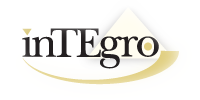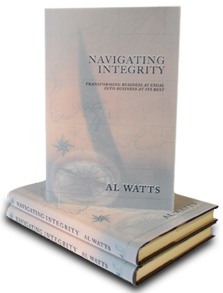We’ve heard a lot lately about how integrity lapses are costly, but less about how integrity drives organizational effectiveness and competitiveness. Part of the reason may be that we associate integrity mainly with only one of Webster’s definitions (the 3rd, actually) – “sound moral principles, uprightness and honesty.” Webster’s first two definitions of integrity, however, speak to being “sound, whole and complete” – concepts clearly linked to leadership and organizational effectiveness. But what does it mean for leaders and organizations to be “whole, sound and complete,” and how does that contribute to the bottom line?
Identity is the foundation for organizational integrity – clarity about purpose, values, strengths and “shadows.” A sense of purpose, grounded by values that people care about, fuel the passion, ingenuity and drive that build competitive advantage. “Strategy 101” out of Michal Porter’s playbook taught us the value of knowing our core competencies; the field of failed leaders and organizations is littered with those that were blind to their shadows.
Sound leaders and sound organizations are authentic, a second characteristic of integrity that includes trueness to purpose, values and goals. Organizations and leaders who are what they say they are inspire confidence, credibility and trust – money in the bank when it comes to employee and customer loyalty.
“Alignment” may be a more business-friendly term than “wholeness,” but they are close cousins. Less energy is wasted in organizations where things like pay, hiring, and performance management send signals that are consistent with stated values and goals. Attention to staying aligned with the market and world around us are akin to Jim Collins’ “adaptive mechanisms;” it helps assure that we remain relevant and attuned to opportunities or threats.
Integrity means that we are accountable – for results that we commit to, for keeping our brand promise and for resources that we influence. “The key to growth (for leaders and organizations,) as Stephen Covey reminds us, “is to learn to make promises and to keep them.”
- How would you rate the effectiveness of your organization leveraging these dimensions of integrity for competitive advantage?
- What should your organization’s next step be to navigate Identity, Authenticity, Alignment or Accountability more effectively?
My new book: Navigating Integrity – Transforming Business As Usual Into Business At Its Best, explores these concepts in depth. You can “Look Inside” and order it now at Amazon.com. Included with each book is a pass code for accessing the online Leadership Integrity Survey, a self-assessment for leaders to get a fix on how they are navigating Identity, Authenticity, Alignment and Accountability.
On April 15, join us at the Metropolitan Ballroom in Minneapolis for ASTD-Twin Cities’ monthly meeting: “Integrity – Your #1 Strategy.”






